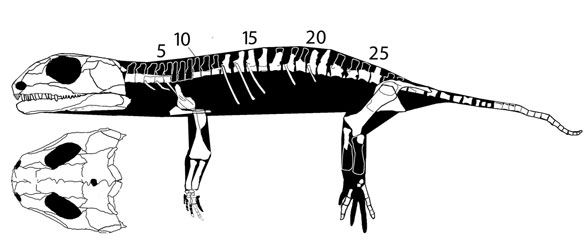| Eureptilia | ||
| The Vertebrates | Eureptilia |
| Vertebrates Home | Vertebrate | Vertebrate |
|
Abreviated Dendrogram
Amniota
├─Synapsida
└─┬─Anapsida
│
└─Eureptilia
├─Coelostegus
└─┬─┬─Thuringothyris
│ └─Captorhinidae
│ ├─Concordia
│ └─┬─Romeria
│ └─┬─Captorhinus
│ └─Moradisaurinae
└─┬─Brouffia
└─Romeriida
├─Paleothyris
└─┬─Hylonomus
└─┬─Protorothyrididae
└─Diapsida
|
Contents
Overview |
During the Middle Carboniferous, the amniote radiation gave rise to three primary clades, the Eureptiles, the Anapsids, and the Synapsids (four if the diadectomorphs were apomorphic, as opposed to crown group) amniotes). In this unit we are concerned with the early Eureptilia (or "Romeriida"), which in earlier books and linnaean taxonomy were called Captorhinomorpha (in a linnaean-cladistic synthesis this would become Paraorder Captorhinomorpha). These were vaguely lizard-like terrestrial forms, characterised by very primitive features, showing that they had only just diverged from their reptiliomorph ancestors.
The evolutionary systematic perspective (e.g. Carroll 1988) presents these early reptiles as the ancestral stem group from which all other reptiles (and from there birds and mammals) evolved, represented as the bubble at the base of the romerogram. But the new cladistic paardigm showed them to be the sister group of the anapsida, the two together constituting the Sauropsida.
The problem with the cladistic model is statigraphic incongruence; the fact that supposedly more basal types don't appear until many millions of years after the more advanced forms. In this case. No anapsid is known prior to the Permian, whilst derived protorythyrids are found in the middle Carboniferous. Frustratingly, no stratocladistic analysis has ever been performed on early amniotes, so we don't know how stratigraphic sequence would constrain phylogeny. As a result are left with a reliance on two selective and less than complete uses of all posisble data, and hence two systems with both persuasive arguments and major shortcomings. Evolutionary systematics requires numerous, far from parsimony, reversals, cladistics a number of ghost lineages and long periods of cryptic evolution.
Hence in understanding these very early and primitive reptiles we are currently limited to a choice between a stratigraphy and phenetics only (no synapomorphies), or a morphology only (no stratiigraphic sequence), approach, the two methodologiesnot unexpectedly resulting in toally different phylogenies. In this unit we have most followed the current cladistic paradigm as far as phylogeny goes, although as a compromise to stratigraphic sequence we are considering Eureptilia, or Paraorder Captorhinomorpha, before Anapsida. MAK120317
Eureptilia: defined as turtle doves > turtles (diapsids > anapsids)
from the Late Carboniferous
Sauropsida : Anapsida + *: Captorhinidae + (Protorothyrididae + Diapsida).
premaxilla without ventral curvature [MR05]; supratemporal small; parietal & squamosal broadly in contact, so that postorbital does not reach supratemporal; tabular not contact opisthotic; jugal anterior process sharply pointed [MR05]; jugal without medial process [MR05]; jugal with distinct anterior and posterior ventral margins [MR05]; stapes short [MR05]; parasphenoid denticulate [MR05]; lower jaw with dorsal ridge [MR05]; retroarticular process absent [MR05]; caniniforms absent [MR05].
Links: link Tree of Life); Reptile Phylogeny 1; PhyloCode Discussion - Message 2001-06-0004- Re- Nomina Conversa problem with the definition); Biology 356 nice discussion); 6SULQJHU another problem).
References: Müller & Reisz (2005) [MR05]. ATW051015.
Late Carboniferous of Nyr'any, Czech Republic.
Eureptilia : ((Captorhinidae + Thuringothyris) + (Protorothyrididae + Diapsida)) + *.
Comments: Most basal Eureptilian, according to Müller & Reisz 2006.

Thuringothyris mahlendorffae Müller J et al. 2006
Early Permian of Germany.
Eureptilia : Coelostegus + ((Protorothyrididae + Diapsida)) + (Captorhinidae + *).
Comments: Originally interpreted as a protorothyridid, cladistic analysis shows it to be a stem captorhinid (Müller & Reisz 2006). This tiny anoimal had a snout-vent length of only 10cm, plaing it in the size range of the earliest amniotes,
Image: illustration copyright David Peters, reproduced with permission
checked ATW050509
Using this material. All material by ATW is public domain and may be freely used in any way (also any material jointly written by ATW and MAK). All material by MAK is licensed Creative Commons Attribution License Version 3.0, and may be freely used provided acknowedgement is given. All Wikipedia material is either Gnu Open Source or Creative Commons (see original Wikipedia page for details). Other graphics are copyright their respective owners